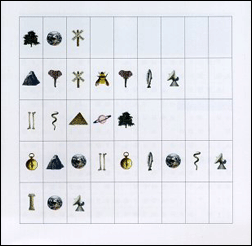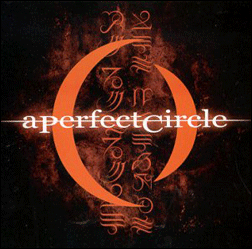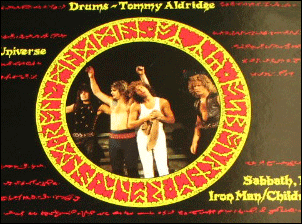Another byproduct of the ‘Code in popular music’ bits I wrote (1, 2) was a slight fascination with ciphered text in the liner notes of various albums. I’ve encountered several great examples of such ciphers, and am curious to learn if there have been other instances. The source of many of my leads in compiling this list is a text-based Cryptorock Summary, crossposted in the alt.rock-n-roll and sci.crypt newsgroups in 1989, though I’ve noticed several post 1989 examples as well.
The most obvious of the more recent examples is ‘Imaginary Day‘ by the Pat Metheny Group. The cover to the album makes it fairly clear that something’s up, and provides enough ‘given’ context that one would have a decent shot at cracking the rest of the symbols even if the key wasn’t provided inside the case.
Inside the booklet, all information is written in this code. An example of how the coded liner notes look can be found here, and a giant scan of the back cover (which features the tracklisting, in code) can be found here. Decoding the notes using the provided key entails properly aligning the disc itself with the artwork beneath the ‘tray’ of the case. Doing so allows each letter of the alphabet (on the under-tray artwork) to show through the clear center of the disc, and align with the corresponding symbol. This cipher was carried over to the packaging for the live DVD release associated with the ‘Imaginary Day’ tour. To avoid in-store confusion, both the CD and DVD are wrapped in a blue strip of paper identifying the item in plain English. This newsgroup posting contains a translation of all of the liner notes.
There is a slightly pointless application based on the cipher available for download at the promotional site for the album. Running the application brings up a screen that translates your keystrokes into the pictoral code. Correctly filling in the blanks with ‘Pat Metheny Group Imaginary Day’ rewards you with a photograph of Metheny sitting with his acoustic guitar, lost in thought. One can only imagine how much Warner Brothers was duped into paying for the development of this ‘intricate’ promotional software back in 1997.
The second example of coded liner notes that I’m aware of is ‘Mer De Noms,’ by Tool off-shoot A Perfect Circle. This is a more subtle example in that there is no key or allusion to the code at all – it has to be deciphered based on context. I wasted an hour or so figuring out the code one sunday morning shortly after ‘Mer de Noms’ first came out, and was pretty pleased with myself. The coded text running down the center of the cover reads ‘La Cascade Des Prenoms’ – a fragment of the original title for the record (‘La cascade de prénoms pour une mer de noms,’ rough translation: the cascade/stream
of first names for a sea of names).
I’ve since sold the CD, and I never gave the code a second thought until It started turning up in my searches for popular music weirdness. Unsurprisingly, there’s all sorts of information on the code online. A no-frills key can be found here. Goth cipher-enthusiasts everywhere can also download the code as a font (‘Mayan’) and hide their tortured missives away from prying eyes. With these resources readily available, it was only a metter of time before ‘Mayan’-coded tattoos started surfacing (It says ‘Evolving.’)
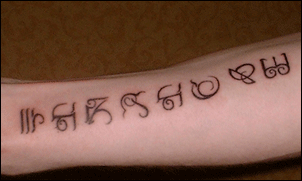
The back of the sleeve to New Order’s ‘Power, Corruption and Lies’ album features a color wheel designed by Peter Saville that was used to encode brief messages on many New Order releases (Power Corruption & Lies, Blue Monday, and Confusion).
Searching through New Order’s official FAQ reveals a description of the decoding process, among other useless knowledge (ie “What record was [Joy Division singer] Ian Curtis listening to when he hanged himself?” A: Iggy Pop’s ‘The Idiot’):
“To decode the wheel, use only the outer two rings. You could divide the outer
two rings into full colour, various on green, and various on yellow. The inner
segments appear to be meaningless. Start with the full colour sections, the
first of which will be the green one… This is ‘A’. Work your way clockwise
namiong each colour the next letter. There are exactly 26 segments around the
disc. From ‘Z’ work back into the full colours, the first of which is ‘1’. This
means that the full green segment is either ‘A’ or ‘1’, and the colour for ‘I’
is also that for ‘9’.”
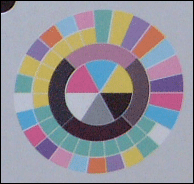
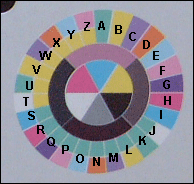
I simplified the directions by making the visual key pictured above. The rest of the New Order messages translate as follows:
- Power, Corruption & Lies LP cover: ‘FACT 75’ [image]
- Power, Corruption & Lies CD cover: ‘FACD 75’
- Inner cover PC&L: ‘Power Corruption And Lies New Order’
- Blue Monday 12″ Sleeve:‘ FAC 73 Blue Monday And The Beach New Order’ [image]
- Confusion Outer Sleeve: ‘FAC 93’ [image]
New order also uses the code on their official website.
Interestingly, another Factory records artist, Section 25, used the same code on the cover of their album ‘From the Hip.’ While I haven’t got a copy to decode, I did find a decent-sized image of the sleeve via this site:
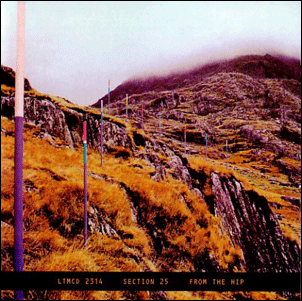
The cover does indeed feature a message coded using the new order color wheel – the upper sections off the posts spell out “From the hip.” This message is repeated in the liner notes as seen below:
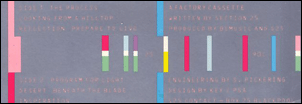
One of the albums cited on the previously mentioned cryptorock list is Ozzy Osbourne’s live album, ‘Speak of the Devil,’ released shortly after guitarist Randy Rhoads died in a plane crash on March 19, 1982. The back cover of the album features both a ring of symbols (which appears to be a key), and numerous strings of smaller symbols in red. The message is described on the list as being a dedication to Randy Rhodes, but I have found no reference online to decoding the message. Clicking the image below should open a larger image of the full back cover in a new window.
Another example of a known code without a method for decoding is the cover to Todd Rundgren’s ‘A Wizard, A True Star,’ which is littered with multicolored banners bearing strings of obscure symbols (Example below). According to the cryptorock list, these translate to “I, Arthur Wood, painted this,” “Be true to your words and your words will be true to you,” “Be true to yourself and your work,” “I will be as true to you as I can,” “Tenderness is the secret to love, as far as I can see,” and “Todd Rundgren.”
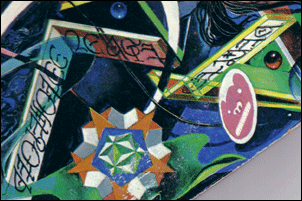
Also of note is the back cover of Paul McCartney’s ‘Red Rose Speedway,’ which features a short message in braille. Said to be for the benefit of Stevie Wonder (Though I can find no confirmation of this and it may be apocryphal), the message reads: “We love you, baby.”
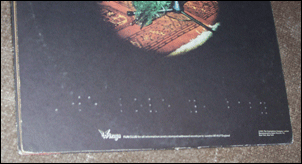
There are several other pre-1989 examples listed in the newsgroup posting, but they are either of dubious quality or too rare for me to easily track down. Is anyone aware of other modern examples?
